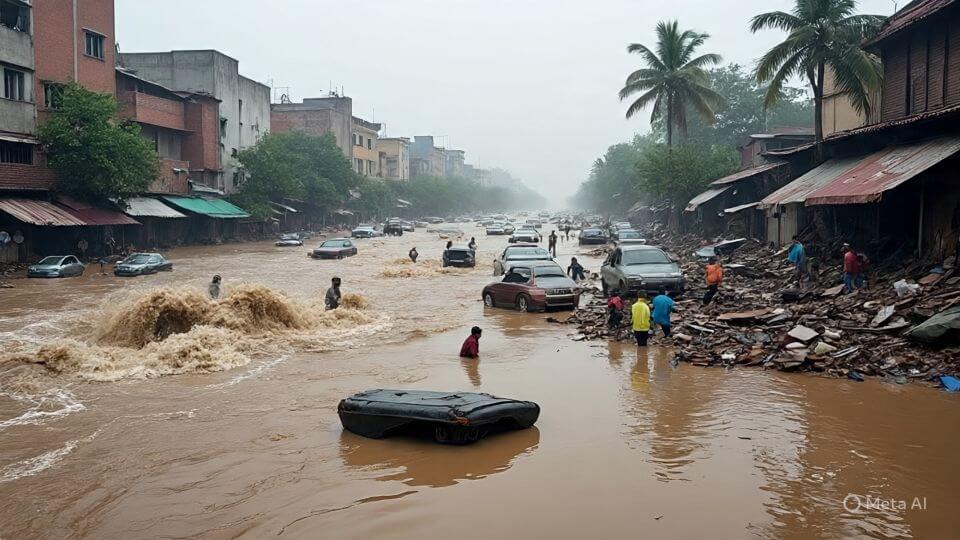In the Philippines, flood control isn’t just a line item—it’s a ritual of waste, denial, and recycled excuses. Over ₱545 billion has been poured into flood mitigation since 2022, yet we still wade through waist-deep water every monsoon season. The latest audit reveals:
- 6,021 projects with no details on what was built—no drainage, no dikes, no pumping stations
- 15 contractors bagging 20% of the total budget, with identical contract prices across different barangays
- 170 pumping stations, 157 of which are in Metro Manila, many clogged with garbage
President Marcos himself called it out: “Some projects exist only in the imagination.” But imagination isn’t waterproof.
🚨 The Real Cost: Agriculture, Livelihoods, and Lives
Flooding isn’t just inconvenient—it’s economically catastrophic. According to the Department of Agriculture:
- Annual losses of 500,000 to 600,000 metric tons of rice due to flooding
- Damage from recent typhoons (Crising, Dante, Emong) reached ₱3.53 billion, affecting 14 regions
- Livestock losses: 46,408 heads of chicken, swine, cattle, and more
- Infrastructure damage: irrigation systems, farm equipment, and machinery
Flood control projects that fail don’t just waste money—they erase futures.
🤖 AI Is Not Missing—We’re Just Ignoring It
While ghost projects multiply, real solutions powered by AI are quietly proving their worth:
- 📡 Valenzuela’s AI-IoT flood warning system uses sensors and machine learning to predict floods in real time
- 🖐️ FloodFinder, a palm-sized device, gives barangays early alerts—solar-powered, no internet required
- 🌐 DICT and JICA’s Spectee platform analyzes social media, weather, and live cams to visualize disaster risks across cities
These tools are scalable, affordable, and already deployed. But they don’t come with ribbon-cuttings or ghost budgets—so they’re ignored.
🏗️ Private Sector Steps In—Because Government Won’t
San Miguel Corporation offered to clean up Metro Manila’s rivers for free. Their Better Rivers PH program has already dredged 8.52 million cubic meters of waste from 163 kilometers of waterways. They even offered to rebuild schools and homes obstructing flood paths.
Meanwhile, the government continues to build dikes on garbage, approve reclamation projects, and blame the weather.
🧠 The Epal Economy: When Failure Becomes a Campaign Strategy
As explored in Epal in the Age of AI, performative politics thrives on visibility—not results. Flood control is the perfect stage:
- Ribbon-cutting ceremonies for drainage systems that don’t drain
- Billboards with smiling faces above submerged barangays
- “Relief ops” livestreamed while the actual relief is delayed
In the AI era, even ghost projects leave digital footprints. And the public is starting to notice.
📸 No Such Thing as Bad Publicity?
As argued in In the Age of AI: Bad Publicity, scandals don’t always sink careers—they amplify them. The more viral the outrage, the more searchable the name. And in a world where AI summarizes reputations, even infamy becomes a form of branding.
“Mahiya naman kayo,” the President said. But shame doesn’t trend. Visibility does.
🧩 The Hypocrisy of Beneficiaries
Let’s be blunt: Even direct beneficiaries of these ghost projects—contractors, local officials, and their families—are now playing innocent.
- Some blame “weather”
- Others say “we didn’t know”
- A few even claim “we were victims too”
But the receipts are digital. The contracts are public. And the hypocrisy is algorithmically traceable.
🎯 Bottom Line: The Flood Isn’t Just Physical—It’s Systemic
This isn’t just about drainage. It’s about:
- A system that rewards visibility over impact
- A culture that treats corruption as tradition
- A digital age where AI will remember what people try to forget
The question isn’t “Who’s guilty?” It’s:
Who’s still pretending to be clean while the water rises?
🧠 Too Cryptic
The flood was never just water. It was a system designed to overflow—contracts, egos, and denial. And in the age of AI, even ghost projects leave digital ghosts.
🧒 Explain Like I’m 12
Imagine your school says they built a new drainage system. But when it rains, your classroom still floods. Then the principal says, “We did our best,” while posting selfies in boots.
That’s what’s happening in real life. The money was spent. The water still came. And now, everyone’s pretending they didn’t see it.
🧨 Bold Conclusion: The Flood Was Engineered—So Was the Forgetting
If they can justify building the wrong bridges by redesigning rivers, they can justify anything—including ghost flood control projects that drown entire barangays.
We’ve seen this playbook before:
- Overpriced laptops for schools that never arrived
- Train wagons bought in 2014 that never rolled
- A bridge that took 10 years to build—and collapsed in two
And now, 6,021 flood control projects with no details, no drainage, and no shame.
They’ll say it was the weather. They’ll say it was “for the boys.” They’ll say it was “completed”—even if it only exists in the imagination.
But the biggest scandal isn’t the corruption. It’s the certainty that we’ll forget.
By 2028, they’ll be back—smiling on tarpaulins, handing out relief goods, and promising “better infrastructure.” And we’ll clap. And we’ll vote. And we’ll drown again.
Shame. Shame. Shame. But the biggest shame is on us—for electing them, again and again.
Flood control isn’t just about water. It’s about how much failure we’re willing to normalize.
So embed your Cersei video. Play the bells. But remember: the walk of atonement only works if someone actually feels shame.
📚 Sources Used
- Bukidnon flood control acceleration
- FFCCCII supports SMC flood cleanup
- SMC’s Better Rivers PH program
- Valenzuela AI-IoT flood warning system
- FloodFinder palm-sized AI device
- DICT-JICA Spectee AI disaster platform
- DA report on agricultural losses due to flooding
- PNA report on flood control anomalies
- Inquirer coverage of Marcos’ “shame on you” speech
- The Diplomat: Flooding and corruption crisis







